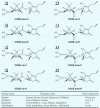Developmental neurotoxicity of pyrethroid insecticides: critical review and future research needs
- PMID: 15687048
- PMCID: PMC1277854
- DOI: 10.1289/ehp.7254
Developmental neurotoxicity of pyrethroid insecticides: critical review and future research needs
Abstract
Pyrethroid insecticides have been used for more than 40 years and account for 25% of the worldwide insecticide market. Although their acute neurotoxicity to adults has been well characterized, information regarding the potential developmental neurotoxicity of this class of compounds is limited. There is a large age dependence to the acute toxicity of pyrethroids in which neonatal rats are at least an order of magnitude more sensitive than adults to two pyrethroids. There is no information on age-dependent toxicity for most pyrethroids. In the present review we examine the scientific data related to potential for age-dependent and developmental neurotoxicity of pyrethroids. As a basis for understanding this neurotoxicity, we discuss the heterogeneity and ontogeny of voltage-sensitive sodium channels, a primary neuronal target of pyrethroids. We also summarize 22 studies of the developmental neurotoxicity of pyrethroids and review the strengths and limitations of these studies. These studies examined numerous end points, with changes in motor activity and muscarinic acetylcholine receptor density the most common. Many of the developmental neurotoxicity studies suffer from inadequate study design, problematic statistical analyses, use of formulated products, and/or inadequate controls. These factors confound interpretation of results. To better understand the potential for developmental exposure to pyrethroids to cause neurotoxicity, additional, well-designed and well-executed developmental neurotoxicity studies are needed. These studies should employ state-of-the-science methods to promote a greater understanding of the mode of action of pyrethroids in the developing nervous system.
Figures




Similar articles
-
Effects of pyrethroids on voltage-sensitive calcium channels: a critical evaluation of strengths, weaknesses, data needs, and relationship to assessment of cumulative neurotoxicity.Toxicol Appl Pharmacol. 2004 Apr 15;196(2):303-18. doi: 10.1016/j.taap.2003.12.013. Toxicol Appl Pharmacol. 2004. PMID: 15081275 Review.
-
Developmental neurotoxicity of pyrethroid insecticides in zebrafish embryos.Toxicol Sci. 2010 Jan;113(1):177-86. doi: 10.1093/toxsci/kfp258. Epub 2009 Oct 27. Toxicol Sci. 2010. PMID: 19861644 Free PMC article.
-
Molecular mechanisms of pyrethroid insecticide neurotoxicity: recent advances.Arch Toxicol. 2012 Feb;86(2):165-81. doi: 10.1007/s00204-011-0726-x. Epub 2011 Jun 28. Arch Toxicol. 2012. PMID: 21710279 Free PMC article. Review.
-
Environmentally relevant mixtures in cumulative assessments: an acute study of toxicokinetics and effects on motor activity in rats exposed to a mixture of pyrethroids.Toxicol Sci. 2012 Dec;130(2):309-18. doi: 10.1093/toxsci/kfs245. Epub 2012 Aug 7. Toxicol Sci. 2012. PMID: 22872056
-
Mechanisms of pyrethroid neurotoxicity: implications for cumulative risk assessment.Toxicology. 2002 Feb 1;171(1):3-59. doi: 10.1016/s0300-483x(01)00569-8. Toxicology. 2002. PMID: 11812616 Review.
Cited by
-
Reference compounds for alternative test methods to indicate developmental neurotoxicity (DNT) potential of chemicals: example lists and criteria for their selection and use.ALTEX. 2017;34(1):49-74. doi: 10.14573/altex.1604201. Epub 2016 Jul 25. ALTEX. 2017. PMID: 27452664 Free PMC article.
-
Using mouse models of autism spectrum disorders to study the neurotoxicology of gene-environment interactions.Neurotoxicol Teratol. 2013 Mar-Apr;36:17-35. doi: 10.1016/j.ntt.2012.08.007. Epub 2012 Sep 7. Neurotoxicol Teratol. 2013. PMID: 23010509 Free PMC article. Review.
-
A current review of cypermethrin-induced neurotoxicity and nigrostriatal dopaminergic neurodegeneration.Curr Neuropharmacol. 2012 Mar;10(1):64-71. doi: 10.2174/157015912799362779. Curr Neuropharmacol. 2012. PMID: 22942879 Free PMC article.
-
Microbial detoxification of bifenthrin by a novel yeast and its potential for contaminated soils treatment.PLoS One. 2012;7(2):e30862. doi: 10.1371/journal.pone.0030862. Epub 2012 Feb 13. PLoS One. 2012. PMID: 22348025 Free PMC article.
-
Temporal variation of residential pesticide use and comparison of two survey platforms: a longitudinal study among households with young children in Northern California.Environ Health. 2013 Aug 20;12:65. doi: 10.1186/1476-069X-12-65. Environ Health. 2013. PMID: 23962276 Free PMC article.
References
-
- Abbey H, Howard E. Statistical procedures in developmental studies on a species with multiple offspring. Dev Psychobiol. 1973;6:329–335. - PubMed
-
- Adams J, Vorhees CV, Middaugh LD. Developmental neurotoxicity of anticonvulsants: human and animal evidence on phenytoin. Neurotoxicol Teratol. 1990;12:203–214. - PubMed
-
- Ahlbom J, Fredriksson A, Eriksson P. Neonatal exposure to a type-I pyrethroid (bioallethrin) induces dose-response changes in brain muscarinic receptors and behaviour in neonatal and adult mice. Brain Res. 1994;645:318–324. - PubMed
-
- Akopian AN, Souslova V, England S, Okuse K, Ogata N, Ure J, et al. The tetrodotoxin-resistant sodium channel SNS has a specialized function in pain pathways. Nat Neurosci. 1999;2:541–548. - PubMed
Publication types
MeSH terms
Substances
LinkOut - more resources
Full Text Sources
Research Materials

